I first visited Moscow in December of 1989 as a tourist on winter break from a program in Russian & Eastern Studies at the University of Kentucky. During one of many bus tours, we stopped at the Kropotkinskaya metro station and piled out into the snow to take pictures of a gigantic, steaming, outdoor swimming pool.
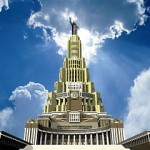 The Moscow Pool (pictured above) was constructed on the site of the original Cathedral of Christ the Savior, destroyed in 1931 to make way for the great Palace of Soviets. Architects proposed what was to be the tallest building on earth, complete with a 30-story statue of Lenin gesturing from its heights toward a bright, communist future. Ironically, neither the monument nor the utopia it was to herald ever materialized.
The Moscow Pool (pictured above) was constructed on the site of the original Cathedral of Christ the Savior, destroyed in 1931 to make way for the great Palace of Soviets. Architects proposed what was to be the tallest building on earth, complete with a 30-story statue of Lenin gesturing from its heights toward a bright, communist future. Ironically, neither the monument nor the utopia it was to herald ever materialized.
My life was to be further entwined with this place on Volkhonka when I returned to Moscow in 1996. For four years, I worked across the street from the construction site where workers were busily erecting a simulacrum of the original cathedral.
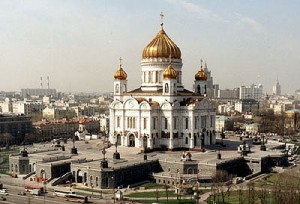 Although the church’s white marble exterior and gold cupolas were meant to reproduce the original in many details, there were also changes. The original church had stood on a hill, while the new cathedral was built instead atop a sprawling complex.
Although the church’s white marble exterior and gold cupolas were meant to reproduce the original in many details, there were also changes. The original church had stood on a hill, while the new cathedral was built instead atop a sprawling complex.
Along with the worship space and the administrative headquarters of the Moscow Patriarchate, the facility includes meeting halls, business offices, eateries, a car wash, and an underground parking garage.
A Russian public service announcement from the time portrays an old woman, a biker, and a businessman as they converge on a single collection box in the snow. The businessman reaches out to place a thick fold of bills into the box, but then defers to the elderly woman who makes her smaller offering in a gesture reminiscent of the gift of the widow’s mite. [1] "One thing unites us all…" an announcer intones, "a cathedral for the whole community. " The newly restored church would be a house of prayer for all the Russian people.
The official site of the Cathedral mentions the solicitation of voluntary public and private donations,[2] but it seemed unlikely at the time that contributions from devout pensioners or well-to-do entrepreneurs could cover the $350 million needed for construction costs. Indeed, substantial government funds were allocated to the project in a Decree signed by Boris Yeltsin in 1992 entitled, "The Establishment of a Fund for the Recreation of Moscow. "[3]
Through all the talk of a church that would help a suffering people to return to their spiritual roots, the holy faith of their ancestors,"[4] the new Cathedral of Christ the Savior is first and foremost yet another manifestation of the complex interplay between ecclesiastical and secular authorities that has characterized the Russian context for a millennium.
Symphonia, or the Orthodox politico-theological notion of the harmonious interrelation of church and state, is nothing new in Russia. The baptism of Prince Vladimir signaled not only the adoption of Christianity in Kievan Rus, but also a political alliance with Byzantium.
Much of the subsequent history of Russian Orthodox symphonia is reinscribed in the reliefs on the outer walls of the new cathedral.
The north and south faces of the church present images from the Hebrew Bible and Russian history as a unified historical trajectory. On the southern wall, David returns from battle with the head of Goliath and Melchizedek blesses Abraham and his troops after their successful campaign against Chedorlaomer of Elam. On the northern face St. Sergius of Radonezh blesses Prince Dmitrii Donskoi before the victory against the Tatars at the Battle of Kulikovo Field in 1380 and the Abbot Dionysus of the Holy Trinity-St. Sergius Monastery blesses Prince Dmitrii Pozharsky before the liberation of Moscow from the Poles, which ended of the Time of Troubles in 1612.
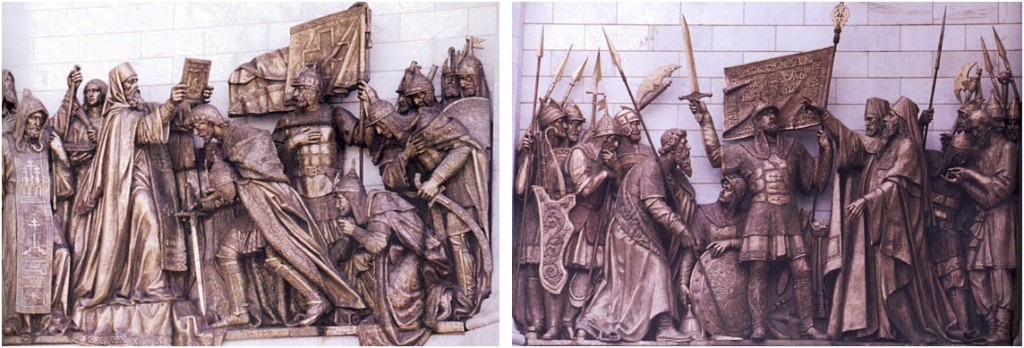
Left: St. Sergius of Radonezh blesses Prince Dmitrii Donskoi / Right: Abbot Dionysus blesses Prince Dmitrii Pozharsky
The west and east walls offer a similar movement from Israel to Russia. The western face (the sunset of history) depicts King David handing over the planning of the Temple to Solomon and Solomon's anointing as king, while the eastern façade (associated in Christian symbolism with new life) includes images of the Nativity and Resurrection of Christ, which flank reliefs of the patron saints and intercessors of Russia, including Metropolitans Peter and Jonah of Moscow and St. Joseph of Volokolamsk. Peter famously allied himself with Grand Prince Ivan Kalita in a move that both consolidated his own power as patriarch and contributed to the rise of Muscovy as a regional power in the 1320s. Jonah was elected metropolitan after the rejection of the Council of Florence in 1443, ending the Russian Church's dependence on Byzantium. [5] Joseph is famous for his two-fold formulation of symphonia that included "complete ecclesiastical support" for the tsar and "a rich and powerful Church. "[6]
The Soviet period brought an end to the carefully brokered division of power between the Russian Church and the Tsar. However, the collapse of communism once again brought new possibilities. In her 2012 monograph Katja Richters advanced the thesis that the Post-Soviet Russian Orthodox Church has moved into a new era of autonomy in which, rather than being used by the state for its own ends, the Church has once again emerged as an independent power with its own agenda. [7]
But the government response to Pussy Riot’s punk prayer stunt in the Cathedral of Christ the Savior has raised concerns that secular authorities might once again be using the Russian Orthodox Church to their own ends. In her current essay, Richters suggests that rather than playing accomplice to the State, the Church's continued negotiation of its own internal diversity and its changing role in society provide a plausible explanation for its lack of coordinated action.
From my own perspective, I'll offer three short observations: one in direct response to Richters' essay, one having to do with the current resurgence of Eastern Orthodoxy as a marker of modern Russian identity, and the third a somewhat playful observation regarding the similarities between the Pussy Riot scandal and the Gospel account of Jesus' cleansing of the Temple.
First, with a conviction rate of 90% in the Moscow court system,[8] it is not necessarily the case that Putin or his immediate staff had anything to do with the conviction and sentencing of the members of Pussy Riot. As the Russian saying goes, the tsar regards with favor, but his kennel master does not. [9]
The role of any servant of the king is to make sure no one rises above his or her station. I propose that such a mentality would obviate the need for executive interference once initial charges were brought before the court.
Officials throughout the Russian bureaucracy act in ways that protect their bosses and curry favor. The Russian judicial system, should one actually fall prey to it, is weighted toward conviction by default. The system is counterbalanced by another Russian myth of the kindly tsar[10] who can alleviate any difficulty if only one can reach him and make one's petition known.
Given these realities, any intervention by executive authority would more likely have been directed toward keeping the conviction from occurring rather than directing how it would be carried out. Indeed, the fact that Prime Minister Dmitri Medvedev suggested that band members should not serve time[11] would tend to indicate either a split between prime minister and president, or, perhaps more likely, a lack of intervention on the part of the executive authority.
Second, a phenomenal religious expansion has taken place in Russia during the first two decades since the collapse of communism.
A 2008 poll reports that 73% of Russian citizens identify as Orthodox Christians. [12] The number of monasteries in Russia expanded from three in 1987 to 478 in 2009, while the number of churches in the country increased from 2,000 under Gorbachev to 13,000 over the same period. [13] The official statistics are mind-boggling, evoking images of a massive spiritual reawakening.
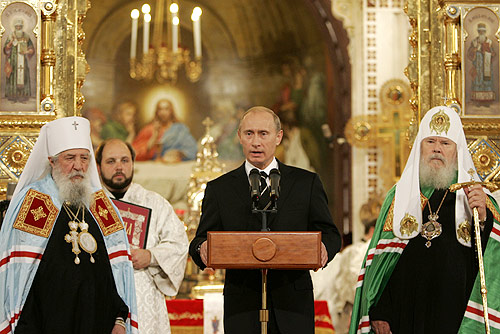 In my own Orthodox jurisdiction in the US, a small but vocal group continues to call for reunification with the Moscow Patriarchate and a repristination of American Orthodoxy as they dream of a renaissance of the deeply spiritual and pious ascetic practice of the days of yore.
In my own Orthodox jurisdiction in the US, a small but vocal group continues to call for reunification with the Moscow Patriarchate and a repristination of American Orthodoxy as they dream of a renaissance of the deeply spiritual and pious ascetic practice of the days of yore.
But my own experiences suggest that reports of religious revival should be taken with a grain of salt. Many of my acquaintances identify as Orthodox simply because they are Russian. Yet they do not attend services in an Orthodox parish, and some of them have not even been baptized. In the popular imagination, Russian and Orthodox simply go together.
Richters observed in her monograph that the current leadership of the Russian Orthodox Church has much less in common with its tsarist predecessors than with the generations produced by the totalitarian regime of the former USSR. [14] I would expand her observation to include the Church's many new members as well. Though the regime has changed, the effects of the Soviet regime remain.
From a distance it is easy to wax philosophical about the mysterious Russian soul. But those new monasteries and parishes springing up throughout the country are filled with neophyte monastics, parishioners, and even priests, who must undergo spiritual formation in the Orthodox phronema in the same manner as any convert here in the United States. Like their American Orthodox brothers and sisters, many are full of us-vs.-them polemics and a desire to see divinely sanctioned retributive justice meted out against those they deem to be Other.
This same lack of spiritual transformation is, in my opinion, responsible for the sentiment behind Metropolitan Hilarion's comments that the Russian Orthodox Church is ready to forgive if the members of Pussy Riot are ready to repent. [15] The Gospel has never stipulated that repentance is a prerequisite for Christian forgiveness, and Christ himself pled from the cross for forgiveness for his executioners, who he claimed didn't know what they were doing. [16]
Finally, I end with a serious if somewhat playful thought experiment.
 Now that Christianity has enjoyed centuries of privilege as a dominant licit religion, many of us are inured to the original scandal of Jesus' prophetic act of overturning the tables of the moneychangers in the Jewish Temple. [17] The Jesus of the Gospels raised a protest that the Temple was to be a house of prayer for all people and condemned practices of his day that had turned this sacred ground into a den of thieves.
Now that Christianity has enjoyed centuries of privilege as a dominant licit religion, many of us are inured to the original scandal of Jesus' prophetic act of overturning the tables of the moneychangers in the Jewish Temple. [17] The Jesus of the Gospels raised a protest that the Temple was to be a house of prayer for all people and condemned practices of his day that had turned this sacred ground into a den of thieves.
New Testament scholars like Greg Carey remind us that from the Roman perspective the disruption caused by Jesus' act of theo-political protest in the height of a holy season was justification enough for the trial and crucifixion that were to follow. [18] While we read the Gospels with the hermeneutic key of Jesus as the Christ, the guardians of the Temple saw only a rogue Galilean desecrating a holy site.
The Gospels tell us that while Pontius Pilate washed his hands of any direct condemnation of Jesus, secular and religious authorities nonetheless collaborated to charge Jesus with blasphemy and treason. Are there any parallels with the punk prayer?
The Cathedral of Christ the Savior complex reserves only 7% of its total space for religious purposes while renting out its halls for private secular events and leasing space to shops that sell jewelry and antiques. Businesses housed onsite include a drycleaner and laundry service, a bakery, and companies that specialize in auto glass replacement and auto repairs, car insurance, and translation services. [19] VIP parking in the church's underground garage costs 450 rubles per day with a minimum six-month contract (or $2,645 at today's exchange rates). [20] The site has come to be derisively referred to in Russia as the "Shopping and Entertainment Center CCS (Cathedral of Christ the Savior). "[21]
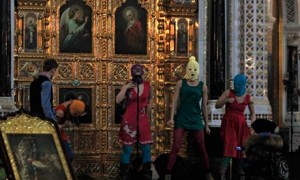 Yet we are scandalized when the members of Pussy Riot cry out, "Shit, Shit, Holy Shit!"[22] in this desecrated space and petition the Virgin Mary to liberate Russia from the current political regime and a clerical hierarchy that sanctions commerce on the temple mount. And while, as Richters points out, President Putin publicly refused to comment on the trial, religious and political voices nonetheless continued to inflame a public that cried out for the Pussy Riot band members to be impaled on pikes. [23]
Yet we are scandalized when the members of Pussy Riot cry out, "Shit, Shit, Holy Shit!"[22] in this desecrated space and petition the Virgin Mary to liberate Russia from the current political regime and a clerical hierarchy that sanctions commerce on the temple mount. And while, as Richters points out, President Putin publicly refused to comment on the trial, religious and political voices nonetheless continued to inflame a public that cried out for the Pussy Riot band members to be impaled on pikes. [23]
Of course, one should not push an analogy too far. I am not claiming that the members of Pussy Riot are somehow divine or even prophets in the spirit of Jeremiah or Isaiah. But is it too much to suggest that their actions in the Cathedral of Christ the Savior may have pulled back the curtain once more to reveal the complex symphonia of church and state relations, upsetting a delicate balance with the declaration that a den of thieves has replaced the house of prayer that was once intended for all the Russian people?
Special thanks to Ed and Laura Aponte for throwing around some ideas with me during the AAR when I was thinking this piece through. The other folks contributing to my thought are in the footnotes below.
[1] Mark 12:41-44; Luke 21:1-4
[2] Participants of the Christ the Savior Cathedral Reconstruction. http://www. xxc. ru/english/reconst/particip/index. htm (last accessed November 23, 2012).
[3] "The Stages of Reconstruction," http://www. xxc. ru/english/reconst/stage/index. htm (last accessed November 24, 2012).
[4] Русская Православная Церковь Кафедральный Собор Патриарха Московского и Всея Руси. http://web. archive. org/web/20000815073801/http://www. xxc. ru/ (last accessed November 27, 2012).
[5] Nicholas V. Riasanovsky, A History of Russia (New York: Oxford University Press, 1984), 103.
[6] Ibid. , 123.
[7] Katja Richters, The Post-Soviet Russian Orthodox Church: Politics, Culture and Greater Russia (New York: Routledge, 2012), 7-8.
[8] Natalia Antonova, "Pussy Riot are scapegoats for Russia's political crisis. " http://www. guardian. co. uk/commentisfree/2012/jun/07/pussy-riot-russia-punk-prayer-service (last accessed November 24, 2012).
[9] Жалует царь, да не жалует псарь.
[10] Сказка о добреньком царе.
[11] Ellen Barry, "Medvedev Says Rockers Have Served Enough Jail Time for Cathedral Performance," New York Times, http://www. nytimes. com/2012/09/13/world/europe/medvedev-says-jailed-pussy-riot-members-in-russia-should-be-freed. html (last accessed November 24, 2012).
[12] Великий пост в жизни россиян. http://wciom. ru/index. php?id=459&uid=10035 (last accessed November 24, 2012) with thanks to John Burgess for pointing me toward the online data of the Russian Public Opinion Research Center.
[13] See Serge Schmemann, “Soul of Russia,” National Geographic Magazine 215/4 (2009), 112−137. MasterFILE Premier, EBSCOhost (accessed November 24, 2012). Special thanks to John Burgess again for this reference.
[14] Richters, 6.
[15] Митрополит Иларион: Простить — не значит дать «зеленый свет» кощунству. http://www. mospat. ru/ru/2012/04/14/news61772/ (last accessed November 24, 2012).
[16] Luke 23:24
[17] Mark 11:15-19; Matthew 21:12-17; Luke 19:45-48; John 2:13-22
[18] Greg Carey, "Occupy Jerusalem: How Jesus Got Himself Killed. " http://www. huffingtonpost. com/greg-carey/occupy-jerusalem-how-jesus-got-himself-killed_b_1100632. html (last accessed November 24, 2012).
[19] Только 7% площадей храма Христа Спасителя отведено под религиозные нужды. http://www. ridus. ru/news/41070/ (last accessed November 24, 2012).
[20] Бизнес-центр Христа Спасителя: Расследование «МН»: кто зарабатывает на главном храме России. http://www. mn. ru/society_faith/20120423/316172981. html (last accessed November 25, 2012).
[21] Торгово-развлекательный центр ХХС (Храм Христа Спасителя). Also торгово-развлекатерльный комплекс ХХС.
[22] The phrase срань господня, literally "shit of the Lord," was coined in the 1990s when American films were bootlegged and sold in street kiosks and video salons throughout Russia. An anonymous voice actor with a very distinctive style used the phrase, which cannot be translated literally, to render English phrases like "holy shit" uttered in scores of Hollywood films. My thanks to Yaroslav Gorbachov for reminding me of this etymology.
For a discussion with Vsevolod Chaplin on the topic of this translation and his feeling that the Russian rendering is much stronger than the original English counterpart, see http://www. pravmir. ru/pravoslavnaya-cerkov-v-rossii-slishkom-mnogo-ili-slishkom-malo-prot-vsevolod-chaplin-vs-dmitrij-lure-video/ (last accessed November 24, 2012).
[23] The Russian expression is посадить на кол and if searched in tandem with the Russian name of the band, Пусси Райт, will produce an endless stream of search engine results from internet discussion threads where such actions are being both recommended and decried.

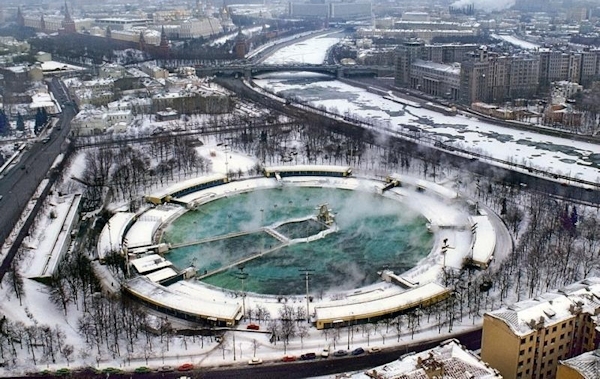
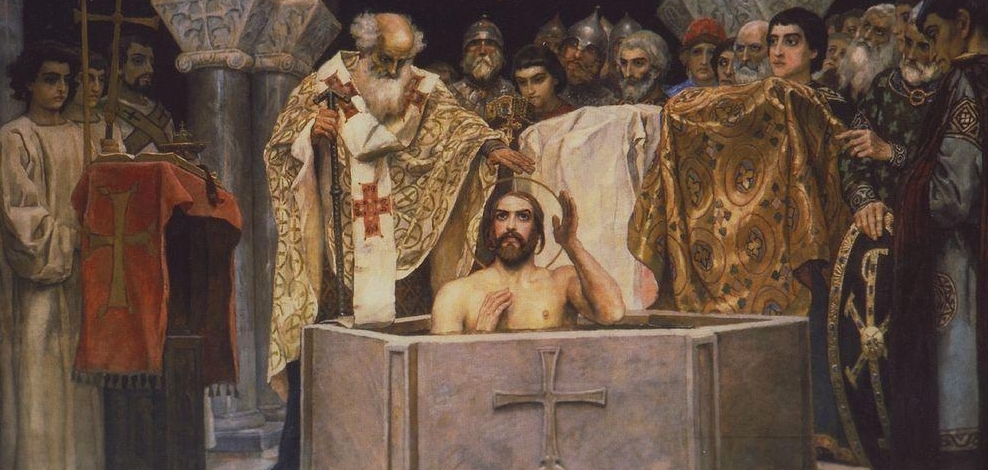
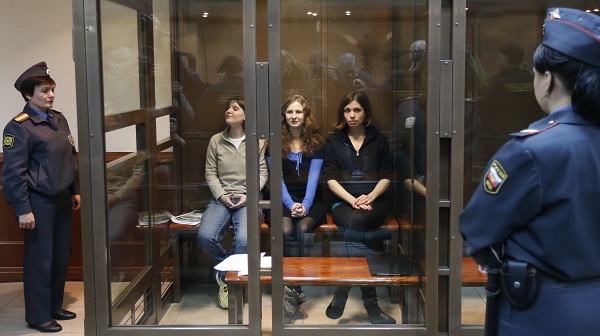



I can't help but wonder how different Russia would be now if the underground elements of the Russian Orthodox Church that resisted the Communists throughout the Soviet Era had been able to come to power after the fall of the Soviet government. The corruption of the sanctioned ROC has continued into the present era, unaccountable and unfettered, as the Pussy Riot episode so poignantly reveals.
Interesting article. It is amazing how the Russian Orthodox Church has become strong again. Sometimes, I wish those anti-religious museums of USSR days like there were once in Kazan Cathedral were preserved to preserve how the Orthodox Church and All Christian Churches have committed terrible acts in the name of Jesus Christ.
The treatment of the " pussy Rioters" and the attacks on GLBT clubs in Moscow by right wing Russian Orthodox groups makes me think it perhaps Russia was better under Communism when the Russian Orthodox Church was persecuted.
Peter Iveson Toronto